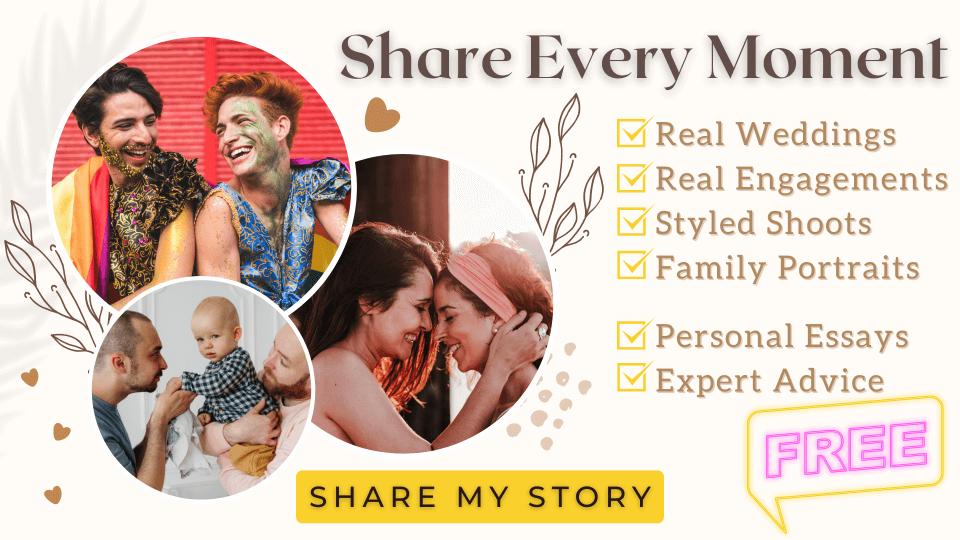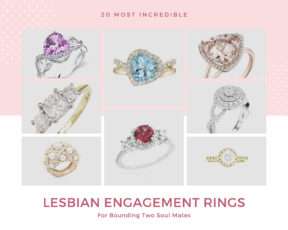A Story Of Veinity: The History Of The Wedding Ring Finger
The story behind which hand we wear our wedding and engagement rings is one of true veinity, coined by the Romans and adopted by many Western cultures.
Centuries ago in ancient Italy where men wore tunics and togas and women wore long flowing gowns, many battles were won, but perhaps some of the most important were the battles of the heart.
Because behind the bravado of the Roman soldier we learned about at school, it turns out that the Romans were rather romantic; they believed that the vein in the fourth finger of the left hand ran directly to the heart, giving it the Latin name vena amoris – and to signify that marriage was a union of love, they wore their wedding ring on the fourth finger of the left hand.
Many Western cultures adopted this custom, which is why so many of us wear our engagement and wedding ring on the fourth finger of the left hand.
This tradition was certainly coined in the UK, but you will find plenty of countries (including some European countries) where it is traditional to wear the wedding ring on the right hand.
Need help finding the perfect jewellers?
Explore our selection of wedding jewellers specialists for the most unique or custom handmade pieces.
Have questions? Ask anything, and our team of experts will be there to help you decide.

As same-sex marriage is embraced by countries and states around the world, couples are asking many time-honoured questions about engagement and wedding rings.
They’re also seeking advice on what is appropriate for gay and lesbian marriages.
Same-sex wedding and engagement ring specialists, Woolton & Hewitt offer their gay wedding ring advice and tips to bear in mind as you select the rings that will forever be symbols of your love.
Ask a wedding jeweller expert
Are you representing a wedding venue?
Join us and place your listing here!
Do gay and lesbian couples exchange engagement rings?
The first thing to say is that there are no established rules. A core theme to same-sex relationships is that of equality. If you decide on a surprise proposal it’s fine to do it without a ring.
This allows you to choose your engagement rings together. Of course, the traditional option of one partner buying an engagement ring for the other is still available.
Some couples, however, may prefer not to give each other engagement rings but to put all their cash into extra special wedding rings.
TIP: When buying engagement rings check that your preferred wedding ring designs will fit neatly alongside. If you think about buying shaped wedding rings make sure you’re happy with their appearance when worn alone.

We exchanged commitment rings years ago, can we use them when we get married?
Yes, how romantic to exchange them again. Or simply wear them as usual and take the opportunity to choose new diamond rings and give those to each other at your wedding. It’s a great way to get those engagement rings you’ve always wanted!
Should we buy gold rings?
Gold is, of course, the most traditional material for a ring. Gold is graded in carats where 24 carats is pure gold.
When mixed with other metals gold becomes much harder wearing so rings are usually made in 9ct or 18ct gold. Gold rings made of 9ct contains 37.5% gold whilst 18ct contains twice as much.
Your rings will be hallmarked by an official assay office with tiny stamps inside the band that confirm the purity, for example, 750 indicates 18ct gold.
What about other precious metals?
Platinum is the most expensive of all the precious metals. It’s naturally white and has been used extensively in fine diamond jewellery.
In the UK you will find rings marked 850, 900 and 950. These are the official grades in parts per thousand. It’s expensive but it’s gorgeous.
A modern alternative is palladium. This is another precious metal that is hallmarked in grades 500 and 950. Again, that’s parts per thousand.
It too is naturally white but with the advantage that it’s less costly. You can expect a palladium 950 ring to be priced somewhere between 9ct and 18ct gold.
TIP: If you’re offered a ring in palladium 500 remember only half is actually precious metal so you should expect the price to be significantly lower than palladium 950 which is 95% pure.
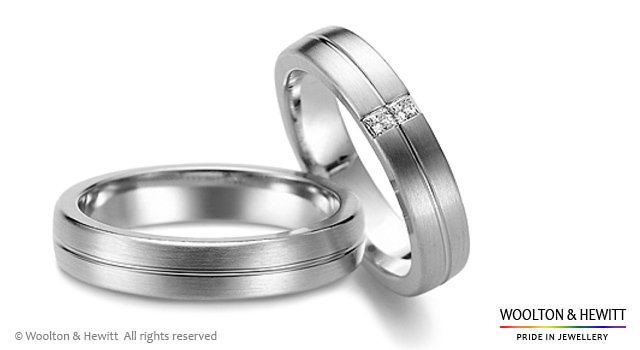
Which colour is best?
That’s really a matter of personal preference. Gold for jewellery comes in three main colours. Yellow, white, and rose or pink gold.
Yellow is the classic colour, white gold (and platinum and palladium) have been very popular in recent years.
Within the gay community pink gold has a strong following. Other options include two or three colour combinations and even multiple shades of gold and platinum that resemble a rainbow.
For wedding rings, grey gold has been introduced and is growing in popularity.
Usually, it is combined with palladium or platinum to create a bi-colour “black and white” effect. It’s plated with ruthenium to achieve a dark finish.
TIP: Yellow gold gives a traditional look, white gold for modernity, two-tones are chic, fly the flag with pink and rainbow gold, and grey gold for the truly unconventional. Just a personal view!
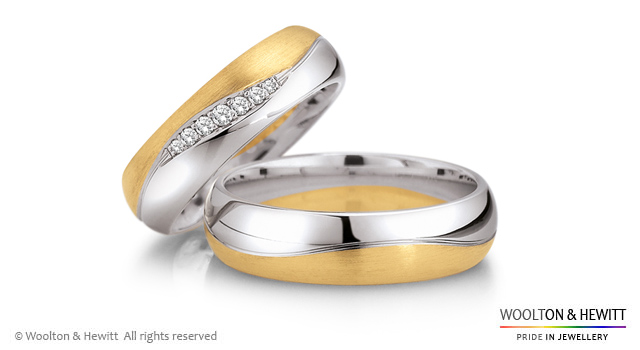
Should we get diamond rings?
Gay and lesbian couples have the freedom to make their own traditions when it comes to marriage.
An engagement ring can be whatever you want it to be. It doesn’t have to be a solitaire diamond on a narrow band or a huge sapphire and diamond cluster. The options are boundless.
Similarly, your wedding rings don’t have to follow the established pattern and be plain gold bands.
Like diamonds, your wedding rings are forever. Many same-sex couples are seizing the opportunity to sparkle and wearing fabulous diamond set designs.
What should we look for in a diamond?
Understanding diamonds is a very technical business. A quick outline follows but the best advice is to buy the best quality diamonds your budget allows from a jeweller you trust.
The 4 Cs (Carat, Colour, Clarity, Cut) give you a good way to delve into diamonds.
- Carat is the weight of the diamond. As a guide, an engagement or wedding ring might have a 0.5 carat single stone or maybe half a dozen small diamonds with a total weight of 0.12 carat.
- Colour is very important and, for diamonds, is graded from D to Z with D being colourless stones, the most prized and therefore the most expensive. At the other end of the scale Z represents a yellowish colour. A good quality ring will contain a “near colourless” stone which is graded G-H.
- Clarity refers to marks within a diamond. These tiny “inclusions” are usually small pieces of carbon that haven’t crystallised. Most engagement and wedding rings will be set with diamonds from the middle of the clarity scale: “very slightly imperfect” ( VS1, VS2) and “slightly imperfect” (SI1, SI2). But we are talking about really tiny marks that you need a magnifying glass to see.
- Cut refers to the shape of the stone. The most usual shapes are round “brilliant” cut, square “princess” cut, and rectangular “baguette” cut. There are many other possibilities too. The choice is yours.
The price of the diamond reflects these and other qualities of the individual stone. And good jeweller will give you the choice, if you wish, to select diamonds that perfectly align with your desires and budget.
TIP: Don’t be rushed into a decision by an apparently huge diamond discount, find rings that are beautifully made and that look beautiful to you and your partner.
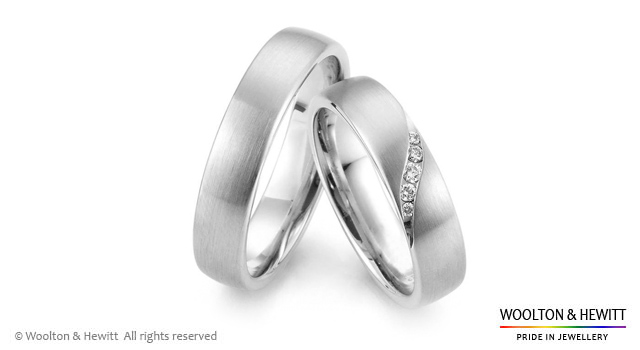
How do we get the right sizes?
Getting the right finger size is really important so your ring is comfortable and won’t fall off!
Points to consider are the width of your new ring, wider ones will probably need to be a little larger. And when taking measurements think about how your finger size varies at different times of the day and at different temperatures.
The best way to establish your size is with a set of professional ring sizers. These can be tried on in jewellery shops or are available online to buy or borrow.
TIP: Individual professional ring sizers are best as you don’t have the weight of all the others pulling on your finger.
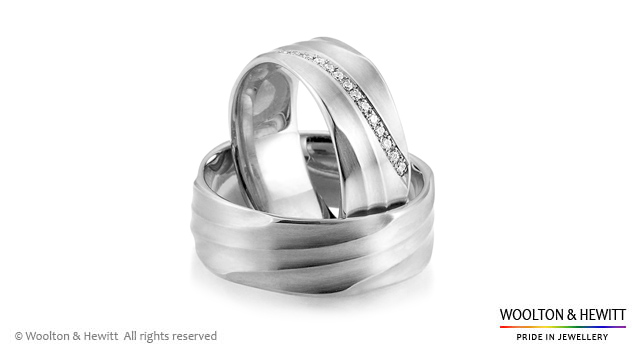
Any final advice?
Just to have fun! Shopping for engagement and wedding rings should be a wonderful and pleasurable experience enjoyed by both of you.
In the high street or browsing online set your sights high. With a little luck it will be love at first sight all over again – then you know you’ve found the perfect rings for you!
View Woolton & Hewitt’s current collection of gay wedding rings and gay engagement rings online or find out more about how they can help you find your perfect wedding ring.

How To: Find An Engagement Ring That Suits Your Hand
Whether you’re blessed with long fingers or short fingers, large hands or stubby ones, London jewellers, Arlington & Co reveal how to find a wedding or engagement ring that suits your hand.
Small Hands, Short Fingers
With small fingers, the objective is to elongate the line of the hand.
Avoid any band that might be too thick; a thin or tapered band is much more flattering.
Elongated diamonds are best as the shape gives the illusion of length to the hand, resulting in slender-looking fingers.
Emerald Cuts, marquise-shaped, pear-shaped or oval-shaped centres can be amazing in terms of creating a longer, more graceful finger line.

Long Fingers
When it comes to styles of engagement rings, long and slender fingers tend to be the most accommodating, and most styles are worn very well.
It is important, though, to keep in mind that you don’t have to go for bold styles; in fact, it is better to choose a design that complements your personal styling.
It is worth noting that round brilliant cut and princess cut diamonds are extremely flattering.

Large Fingers
The key here is to avoid rings that are dainty. A very thin band will make the fingers appear even wider than they actually are.
We would recommend trying on a split shank design, perhaps with a diamond set surround – by breaking up and widening the shank, you achieve more coverage on the finger itself and it can be extremely flattering to the eye.
A splash of colour for the more daring also works beautifully.
Watch the Video
Discover how a wedding ring and an engagement ring are made in these fantastic videos.
How To: Make An Engagement Ring
Ever wondered how an engagement ring is made?
Master goldsmiths at Arlington & Co, the bespoke wedding jewellers, show you how in this video.
How To: Make An Wedding Ring
Find out how to find a ring that suits your hand, and discover more about Arlington & Co and the types of settings and gemstones for your perfect gay or lesbian wedding rings.

